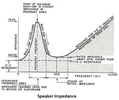I've attached a picture of the project in question. Without pairing the Bluetooth receiver with a Bluetooth transmitter, If I measure the impedance of the inputs (bottom of the picture) on the amp board, it measures 4.0 ohms, which makes sense since the speaker is 4 ohms. However, still without any Bluetooth pairing, if I measure the impedance of the terminal block mount connector, (put the positive multimeter lead on either of the combined channel outputs and the negative lead on the ground output) this reads between 3.65 and 3.8 ohms. Two questions about this discrepancy. Why is there a discrepancy between this and the input ohms reading, and why don't I always get the same reading.
As soon as I pair the Bluetooth receiver, the ohms reading on the amp board goes down to either 0.9 or 1.0, and the ohms reading on the terminal block mount connector goes to 0. Please also explain why the Bluetooth pairing lowers the ohms reading for both measurements, and why it affects them differently.
In this thread (https://www.electro-tech-online.com/threads/capacitor-to-eliminate-speaker-hum.163451/) which deals with a similar circuit where I used two amp boards to make a stereo system, I mentioned how the Bluetooth pairing was beneficial, since it eliminated most of the speaker hum. With that in mind, I have an additional question about this setup. If I were to remove the Bluetooth receiver and directly connect an audio device to the circuit with a 3.5 mm connection, would the sound be any different, or would the battery life be any different? I'm guessing the answer is no, but I asked because I'm curious whether these different impedance readings the Bluetooth pairing causes are doing anything to change the character of the amplification, and/or the sound.

As soon as I pair the Bluetooth receiver, the ohms reading on the amp board goes down to either 0.9 or 1.0, and the ohms reading on the terminal block mount connector goes to 0. Please also explain why the Bluetooth pairing lowers the ohms reading for both measurements, and why it affects them differently.
In this thread (https://www.electro-tech-online.com/threads/capacitor-to-eliminate-speaker-hum.163451/) which deals with a similar circuit where I used two amp boards to make a stereo system, I mentioned how the Bluetooth pairing was beneficial, since it eliminated most of the speaker hum. With that in mind, I have an additional question about this setup. If I were to remove the Bluetooth receiver and directly connect an audio device to the circuit with a 3.5 mm connection, would the sound be any different, or would the battery life be any different? I'm guessing the answer is no, but I asked because I'm curious whether these different impedance readings the Bluetooth pairing causes are doing anything to change the character of the amplification, and/or the sound.
Last edited:


